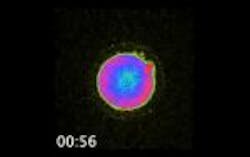Fluorescence microscopy shows function that could pinpoint best eggs for IVF
Fluorescence microscopy enabled researchers at Northwestern University (Chicago, IL) to reveal that zinc "explosions" occur when a human egg is activated by a sperm enzyme, and that the size of these "sparks" is a direct measure of the quality of the egg and its ability to develop into an embryo. The discovery has the potential to help doctors choose the best eggs to transfer during in vitro fertilization (IVF), the researchers say.
Related: Fluorescent-coated optical fiber sensor could monitor IVF noninvasively
In their study, the researchers activated the egg by injecting a sperm enzyme (actual sperm is not permitted in human research under federal law) into the egg that triggers calcium to increase within the egg and zinc to be released from the egg. As the zinc is released from the egg, it binds to small molecule probes, which emit light in fluorescence microscopy experiments. Thus, the rapid zinc release can be followed as a flash of light that appears as a spark.
"These fluorescence microscopy studies establish that the zinc spark occurs in human egg biology, and that can be observed outside of the cell," says Tom O'Halloran, the Charles E. and Emma H. Morrison Professor in Chemistry in the Weinberg College of Arts and Sciences and director of Northwestern's Chemistry of Life Processes Institute, who is a co-senior author of the study. Teresa Woodruff, the Thomas J. Watkins Memorial Professor in Obstetrics and Gynecology at the Northwestern University Feinberg School of Medicine and director of Northwestern’s Center for Reproductive Science, is the other senior author and an expert in ovarian biology.
Eggs compartmentalize and distribute zinc to control the development of a healthy embryo. Over the last six years, the research team has shown that zinc controls the decision to grow and change into a completely new genetic organism.
"This is an important discovery because it may give us a noninvasive and easily visible way to assess the health of an egg and eventually an embryo before implantation," says co-author Dr. Eve Feinberg, who took care of the patients who provided eggs for the basic science study and collaborated with the research team.
First author Francesca Duncan made the human zinc spark discovery. "We now know that the release of zinc at the time of fertilization is a conserved phenomenon, which will help us address one of the largest unanswered questions in reproductive medicine—what makes a good egg?" Duncan says.
Full details of the work appear in the journal Scientific Reports; for more information, please visit http://dx.doi.org/10.1038/srep24737.
